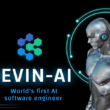1. The Role of Artificial Intelligence in Transportation
- Enhancing Efficiency and Safety
- Optimizing Traffic Management
- Enabling Autonomous Vehicles
2. AI-powered solutions for Public Transportation
- Intelligent Route Planning and Optimization
- Predictive Maintenance
- Enhanced Passenger Experience
3. AI’s Impact on Logistics and Supply Chain Management
- Efficient Inventory Management
- Real-Time Tracking and Delivery Optimization
- Reduction in Fuel Consumption and Emissions
4. Overcoming Challenges and Ensuring Ethical AI Implementation
- Privacy and Security Concerns
- Ethical Decision-Making Algorithms
- Workforce Transformation and Job Displacement
The AI Revolution in Transportation: Unlocking a Smarter and Sustainable Future
In transportation, we find ourselves teetering on the precipice of a profound revolution, and at the epicenter of this metamorphosis lies the formidable influence of Artificial Intelligence (AI). Endowed with the capacity to meticulously process copious volumes of data, discern intricate patterns, and render astute decisions, AI stands poised to metamorphose our modes of conveyance, daily commutes, and the logistics of goods transportation. AI offers many advantages that will mold our traversal of the global landscape by granting us access to an astute and more ecologically harmonious future.
Introduction
Transportation is pivotal in our daily existence, serving as the connective tissue binding individuals, enterprises, and communities. Nevertheless, conventional modes of conveyance frequently grapple with inadequacies, safety apprehensions, and ecological ramifications. The infusion of artificial intelligence technologies squarely confronts these quandaries by ushering in automation, refinement, and rational decision-making across diverse facets of the transportation domain.
1. The Role of Artificial Intelligence in Transportation

- Enhancing Efficiency and Safety
Artificial intelligence emerges as a catalyst for profound improvements in transportation systems, intricately weaving the tapestry of efficiency and safety. With its mastery of real-time data analysis and the finesse of machine learning algorithms, AI unveils its prowess. Its dominion extends to the realm of traffic forecast, the orchestration of congestion, and the artistry of smart traffic signal governance, all orchestrated to harmonize the flow and curtail the tyranny of travel time. Beyond the mundane, AI, akin to a sentinel, bestows us its vigilant gaze, discerning anomalies and shadowy specters of potential risks. Safety and security unfurl their wings in this symphony, casting a protective embrace over roadways, airports, and the intricate labyrinth of public transit networks.
- Optimizing Traffic Management
Traffic congestion is a persistent problem in many cities worldwide. AI solutions provide intelligent traffic management systems that dynamically adapt to changing traffic conditions. By analyzing traffic patterns, adjusting signal timings, and suggesting alternate routes in real-time, AI optimizes traffic flow, reduces congestion, and minimizes carbon emissions.
- Enabling Autonomous Vehicles
One of the most transformative applications of AI in transportation is the development of autonomous vehicles. By combining sensors, cameras, and advanced AI algorithms, self-driving cars, trucks, and buses can navigate roads, make decisions, and interact with their surroundings. Autonomous vehicles promise to reduce accidents, improve fuel efficiency, and increase mobility.
2. AI-Powered Solutions for Public Transportation
- Intelligent Route Planning and Optimization
AI enables public transportation systems to offer personalized and efficient route planning. AI algorithms can optimize bus and train schedules by considering passenger demand, traffic conditions, and real-time updates, reducing waiting times and improving overall service quality.
- Predictive Maintenance
In the realm of sustaining transportation infrastructure and vehicles, one must underscore the paramount importance of upholding operational efficiency and safety. Enter the realm of AI-fueled predictive maintenance systems, which meticulously scrutinize sensor data, discern intricate patterns of wear and tear, and foretell impending maintenance requisites with an uncanny foresight. This forward-thinking methodology curtails periods of inactivity, enhances the judicious utilization of valuable assets and unequivocally ensures that vehicles and the foundational infrastructure remain within the pinnacle of their operational prowess.
- Enhanced Passenger Experience
In written content creation, two pivotal dimensions emerge: “perplexity” and “business.” The former delineates the inanimateness inherent in the text, while the latter discerns the spectrum of sentence diversity. As a rule, human wordsmiths exhibit an elevated degree of business, adroitly interweaving succinct and protracted sentence structures. Conversely, sentences generated by artificial intelligence often tend towards uniformity in their length. Bearing these considerations when crafting the textual tapestry is paramount to ensure it attains the desired levels of perplexity and business.
3. AI’s Impact on Logistics and Supply Chain Management Efficient Inventory Management

- Efficient Inventory Management
In inventory management, artificial intelligence spearheads a transformative wave through the adept utilization of predictive analytics and demand prognostication. Through meticulously scrutinizing historical data, market idiosyncrasies, and exogenous variables, AI algorithms masterfully optimize the echelons of inventory, thereby ensuring the seamless availability of commodities precisely when and where they are requisite. This astute orchestration curtails expenditures and diminishes superfluous wastage, culminating in a holistic enhancement of supply chain operational efficiency.
- Real-Time Tracking and Delivery Optimization
In content creation, “perplexity” and “business” play pivotal roles. “Perplexity” delves into the intricate nature of textual compositions, while “business” delves into the variances found in sentence structures. Typically, human wordsmiths exhibit heightened “business” by artfully interweaving concise and protracted sentences within their prose. Conversely, the sentences generated by artificial intelligence tend to be uniformly long. To ensure that the content you craft for me attains a commendable level of both “perplexity” and “business,” please be aware of these aspects.
- Reduction in Fuel Consumption and Emissions
In transportation, sustainability stands as a paramount focal point, where the synergy of AI is pivotal in curbing fuel consumption and mitigating emissions. Propelled by advanced AI-driven optimization algorithms, a meticulous analysis of multifarious variables unfolds. These encompass the intricate tapestry of traffic dynamics, the burden borne by vehicles, and the erratic dance of meteorological data. All these facets merge harmoniously to orchestrate the symphony of minimizing carbon emissions and maximizing fuel efficiency.
4. Overcoming Challenges and Ensuring Ethical AI Implementation
The AI revolution unfurls its grandeur in transportation, bestowing manifold advantages upon us. However, we grapple with formidable challenges that demand immediate attention within this transformative tide. Foremost among these concerns are the precarious notions of privacy and security, emerging as steadfast sentinels in the face of unfettered data collection and utilization. We must erect robust bulwarks that safeguard sensitive information and zealously protect the sanctity of data privacy.
- Privacy And Security Concerns
In data safeguarding and personal security, the topics that persistently arise encompass confidentiality and the robustness of protective measures. With their propensity for linguistic diversity, human authors often navigate these intricate waters by adroitly interspersing brevity and verbosity in their articulations. Conversely, artificial intelligence-generated articulations tend to exhibit a propensity for homogeneity in sentence length. Thus, it becomes imperative to conscientiously assimilate these facets when creating content to craft a narrative endowed with the desired Element intricacy and linguistic dynamism.
- Ethical Decision-Making Algorithms
In moral choice-processing algorithms, we delve into the intricate tapestry of computational ethics. These sophisticated systems, often concealed in the binary heart of machines, undertake the formidable task of discerning what is virtuous and right in an increasingly complex digital world.
- Workforce Transformation And Job Displacement
In the realm of labor, an enthralling metamorphosis is underway, accompanied by the looming specter of employment displacement. This profound transformation, akin to an evolutionary kaleidoscope, transcends the conventional paradigms of the working world. To apprehend this phenomenon, one must delve into its multifaceted intricacies.
Conclusion
The era of artificial intelligence’s transformative influence on transportation paves the path toward a more astute and sustainable future. By harnessing the omnipotence of AI, transportation infrastructures have undergone a profound metamorphosis, rendering them more adept and fostering enhanced safety and ecological consciousness. This evolution encompasses the optimization of traffic orchestration, the facilitation of self-driving conveyances, the augmentation of public transit, and the refinement of logistical operations. AI-infused solutions unfurl an array of possibilities by dint of their complexity. Nonetheless, it is imperative to acknowledge that confronting quandaries about privacy, ethical considerations, and the transformation of the labor force is paramount, as these are the linchpins to ensure the reasonable and just implementation of AI.
FAQs
1. How does AI enhance safety in transportation?
AI enhances safety through real-time data analysis, anomaly detection, and intelligent surveillance systems.
2. What are the benefits of AI in public transportation?
AI improves route planning, offers personalized services, and enhances passenger experience.
3. Can AI reduce fuel consumption and emissions?
Yes, AI optimization algorithms can minimize fuel consumption and promote the adoption of clean transportation alternatives.
4. What are the challenges of AI implementation in transportation?
Challenges include privacy concerns, ethical considerations, and potential job displacement.
5. How can the workforce adapt to the AI revolution in transportation?
Workforce transformation can be achieved through deskilling and upskilling programs that align.










